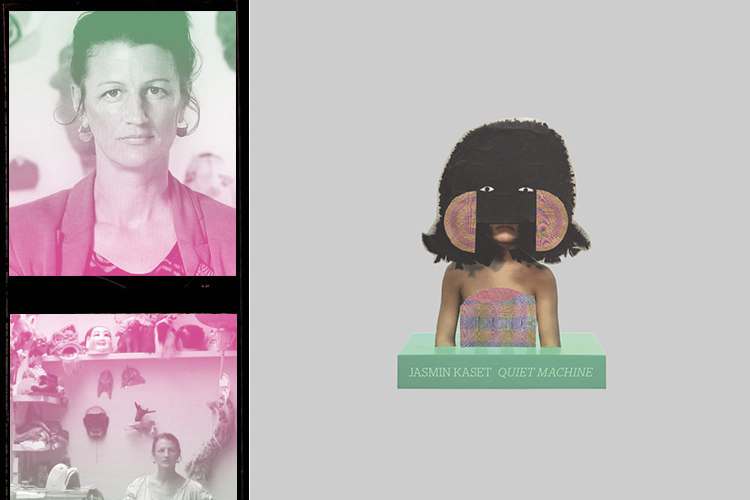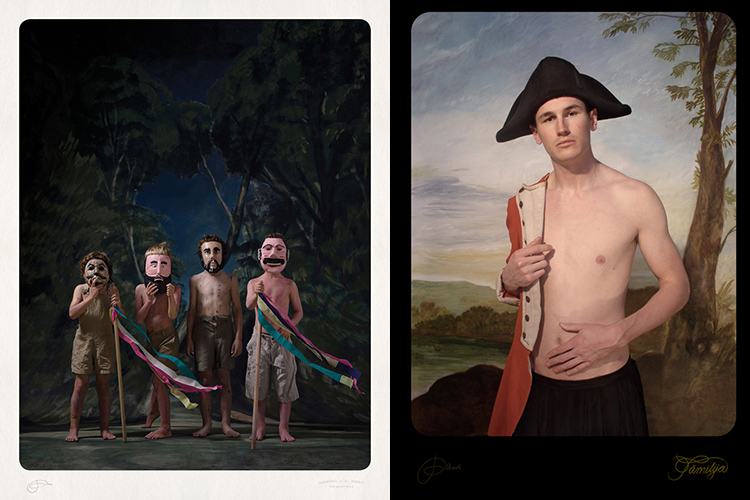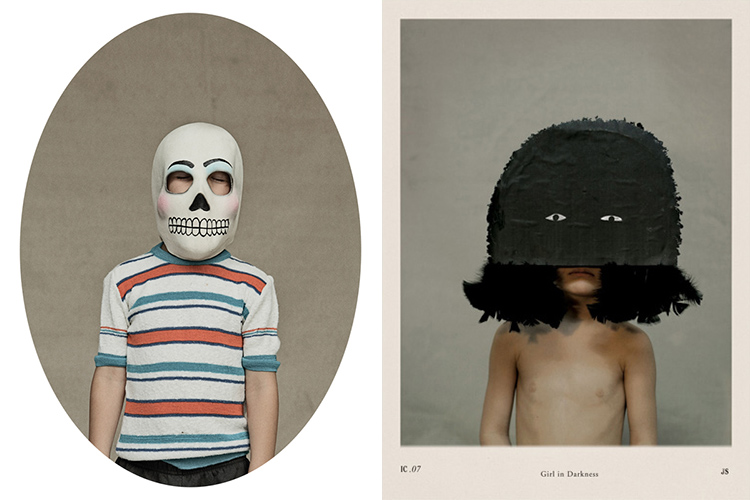Jacqui Stockdale and Quiet Machine
posted January 29, 2014 #
The new Jasmin Kaset album has a rather compelling bit of art adorning its cover (in my opinion). It's a slightly modified piece from renowned Australian artist Jacqui Stockdale. At the moment, she has a few pieces hanging in the Louvre and a new series of portraits, Super Naturale, opening in March at the Helen Gory Galerie in Melbourne.
Her work runs a wide gamut both in terms of the feelings it stirs up and the methods of execution. I highly recommend taking some time with her portfolio, it's rewarding in a number ways. She was also gracious enough to answer a few questions about her background, her process, the nature of historical influence, collaboration and plenty more.
First off, can you give the readers a little background on yourself? Did you set out to be a fine artist or happen into it?
Well, it happened quite naturally, I became interested in art at high school, and with the encouragement of my parents, went straight into studying Fine Art at a Technical College in a small country town in North East Victoria until I was accepted into the VCA, the National Gallery School in Melbourne, to study painting. After graduating at age 21, I rented studios and started exhibiting around Australia in group and solo shows and supported myself with a variety of part-time jobs.
Your portraiture is phenomenal. It evokes a surreal, sometimes whimsical, sometimes foreboding, feel. Can you speak to what inspires these creations?
Thank you, I like your description of my portraits, I can relate. I think that there are so many things that inspire the work, as with most artists these days, we are exposed to such a vast array of images, we travel like never before and the Internet has opened our world up and given us an intimate look into every backyard imaginable, be it political, cultural, environmental, geographical or purely visual. So my work is not surprisingly a mix of influences. However, I am repeatedly drawn to a particular type of portraiture, either through painting or photography. It is where the composition is staged and the subject is posing, for example as in the early years of photography, that followed the genre of regal European portrait painting. Humans have always had a fascination for other cultures, for the exotic and foreign, this became a phenomena when the world was opening up to travel and it was only through art/photography were we could see what how other people lived. Of course it was often from a Colonial perspective and often portrayed as somewhat voyeuristic or exoticised. As a playful response to these images, I feel that some of my work has a tongue in cheek tone to it, such as in Lady Rabbit and Colonial Boy (the subject is Jasmin's husband Luke, my fabulous brother) from a series called Familija (family), 2005. I am also drawn to masquerade and how it enables a human subject to transform. In Australia, it is very rare to find a culture that uses masks as part of transformative rituals, even through festivals, except in some indigenous cultures such as Torres Straight Islands and in Arnhem Land in the Northern Territory. In April this year I will be taking up a three month residency in Barcelona, Spain with the aim to witness first hand certain rituals, Carnivals and Fiestas that have inspired me for some time. They are a vibrant and sometimes bizarre mix of folk, pagan and Catholic traditions.
The cover for Quiet Machine is taken from your Isola Corpo Portraits series (Girl in Darkness). Can you talk about the creation of these portraits and their concept?
There are five portraits in the series, Isola Corpo means island body. I photographed myself, my niece, my sister and two friends. It plays around with the idea that as humans we are like Islands, isolated human entities yet part of a greater mass, metaphorically aligned to archipelagos and continents. A bit, No Man an Island sort of thing. Being connected through bloodlines, stories, culture, memories and myths. Out all of the work I have made, Girl in Darkness, seems to really strike a chord with my audience. I am always hoping to create something like this again; it is not really in my control, some images have a way of connecting with people, they have their own soul.
How do you feel about it being reworked into another piece?
I love nothing more than for my images to transform themselves, to reappear in a new context. The original portrait, Girl in Darkness, 2005 is a photograph of my 5 year old niece wearing a paper mask with feathers. Just last year, while working on a series of collages, I cut up an artist's proof of this image and added some new pieces cut from an art magazine. When I contacted the Melbourne artist, John Aslanidis for permission to use his 'bits' he described my process as, 'like sampling music'. So it seems appropriate that it is now spinning around on Jasmin's latest record cover, Quiet Machine, its quite an honour.
Huge thanks to Jacqui Stockdale for taking the time to answer my questions and, moreso, for contributing to Quiet Machine. It is a compelling piece of work. See more of her creations on her site or dig into this essay for some more thought provoking insight.
Her work runs a wide gamut both in terms of the feelings it stirs up and the methods of execution. I highly recommend taking some time with her portfolio, it's rewarding in a number ways. She was also gracious enough to answer a few questions about her background, her process, the nature of historical influence, collaboration and plenty more.
First off, can you give the readers a little background on yourself? Did you set out to be a fine artist or happen into it?
Well, it happened quite naturally, I became interested in art at high school, and with the encouragement of my parents, went straight into studying Fine Art at a Technical College in a small country town in North East Victoria until I was accepted into the VCA, the National Gallery School in Melbourne, to study painting. After graduating at age 21, I rented studios and started exhibiting around Australia in group and solo shows and supported myself with a variety of part-time jobs.
Your portraiture is phenomenal. It evokes a surreal, sometimes whimsical, sometimes foreboding, feel. Can you speak to what inspires these creations?
Thank you, I like your description of my portraits, I can relate. I think that there are so many things that inspire the work, as with most artists these days, we are exposed to such a vast array of images, we travel like never before and the Internet has opened our world up and given us an intimate look into every backyard imaginable, be it political, cultural, environmental, geographical or purely visual. So my work is not surprisingly a mix of influences. However, I am repeatedly drawn to a particular type of portraiture, either through painting or photography. It is where the composition is staged and the subject is posing, for example as in the early years of photography, that followed the genre of regal European portrait painting. Humans have always had a fascination for other cultures, for the exotic and foreign, this became a phenomena when the world was opening up to travel and it was only through art/photography were we could see what how other people lived. Of course it was often from a Colonial perspective and often portrayed as somewhat voyeuristic or exoticised. As a playful response to these images, I feel that some of my work has a tongue in cheek tone to it, such as in Lady Rabbit and Colonial Boy (the subject is Jasmin's husband Luke, my fabulous brother) from a series called Familija (family), 2005. I am also drawn to masquerade and how it enables a human subject to transform. In Australia, it is very rare to find a culture that uses masks as part of transformative rituals, even through festivals, except in some indigenous cultures such as Torres Straight Islands and in Arnhem Land in the Northern Territory. In April this year I will be taking up a three month residency in Barcelona, Spain with the aim to witness first hand certain rituals, Carnivals and Fiestas that have inspired me for some time. They are a vibrant and sometimes bizarre mix of folk, pagan and Catholic traditions.
The cover for Quiet Machine is taken from your Isola Corpo Portraits series (Girl in Darkness). Can you talk about the creation of these portraits and their concept?
There are five portraits in the series, Isola Corpo means island body. I photographed myself, my niece, my sister and two friends. It plays around with the idea that as humans we are like Islands, isolated human entities yet part of a greater mass, metaphorically aligned to archipelagos and continents. A bit, No Man an Island sort of thing. Being connected through bloodlines, stories, culture, memories and myths. Out all of the work I have made, Girl in Darkness, seems to really strike a chord with my audience. I am always hoping to create something like this again; it is not really in my control, some images have a way of connecting with people, they have their own soul.
How do you feel about it being reworked into another piece?
I love nothing more than for my images to transform themselves, to reappear in a new context. The original portrait, Girl in Darkness, 2005 is a photograph of my 5 year old niece wearing a paper mask with feathers. Just last year, while working on a series of collages, I cut up an artist's proof of this image and added some new pieces cut from an art magazine. When I contacted the Melbourne artist, John Aslanidis for permission to use his 'bits' he described my process as, 'like sampling music'. So it seems appropriate that it is now spinning around on Jasmin's latest record cover, Quiet Machine, its quite an honour.
Huge thanks to Jacqui Stockdale for taking the time to answer my questions and, moreso, for contributing to Quiet Machine. It is a compelling piece of work. See more of her creations on her site or dig into this essay for some more thought provoking insight.



